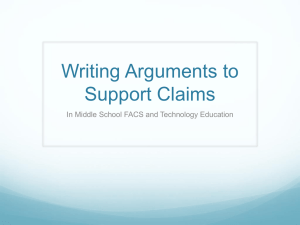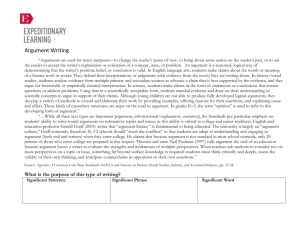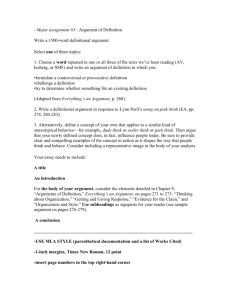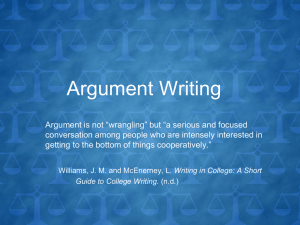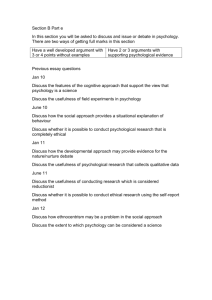Writing Arguments to Support Claims in Social Studies
advertisement
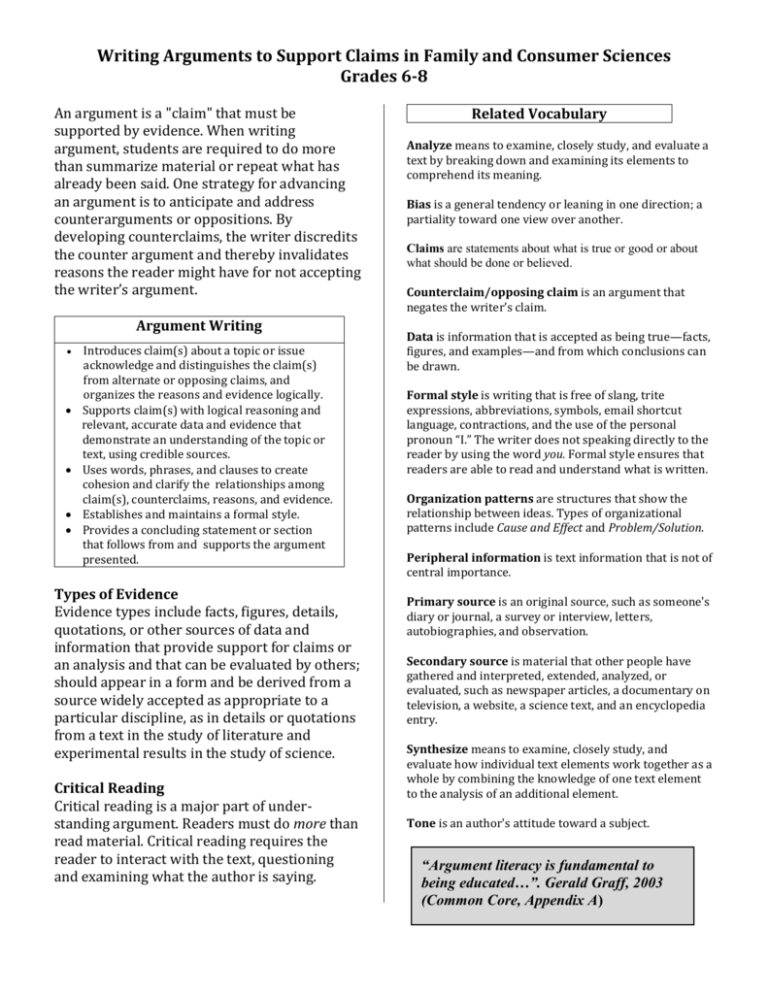
Writing Arguments to Support Claims in Family and Consumer Sciences Grades 6-8 An argument is a "claim" that must be supported by evidence. When writing argument, students are required to do more than summarize material or repeat what has already been said. One strategy for advancing an argument is to anticipate and address counterarguments or oppositions. By developing counterclaims, the writer discredits the counter argument and thereby invalidates reasons the reader might have for not accepting the writer’s argument. Argument Writing Introduces claim(s) about a topic or issue acknowledge and distinguishes the claim(s) from alternate or opposing claims, and organizes the reasons and evidence logically. Supports claim(s) with logical reasoning and relevant, accurate data and evidence that demonstrate an understanding of the topic or text, using credible sources. Uses words, phrases, and clauses to create cohesion and clarify the relationships among claim(s), counterclaims, reasons, and evidence. Establishes and maintains a formal style. Provides a concluding statement or section that follows from and supports the argument presented. Types of Evidence Evidence types include facts, figures, details, quotations, or other sources of data and information that provide support for claims or an analysis and that can be evaluated by others; should appear in a form and be derived from a source widely accepted as appropriate to a particular discipline, as in details or quotations from a text in the study of literature and experimental results in the study of science. Critical Reading Critical reading is a major part of understanding argument. Readers must do more than read material. Critical reading requires the reader to interact with the text, questioning and examining what the author is saying. Related Vocabulary Analyze means to examine, closely study, and evaluate a text by breaking down and examining its elements to comprehend its meaning. Bias is a general tendency or leaning in one direction; a partiality toward one view over another. Claims are statements about what is true or good or about what should be done or believed. Counterclaim/opposing claim is an argument that negates the writer’s claim. Data is information that is accepted as being true—facts, figures, and examples—and from which conclusions can be drawn. Formal style is writing that is free of slang, trite expressions, abbreviations, symbols, email shortcut language, contractions, and the use of the personal pronoun “I.” The writer does not speaking directly to the reader by using the word you. Formal style ensures that readers are able to read and understand what is written. Organization patterns are structures that show the relationship between ideas. Types of organizational patterns include Cause and Effect and Problem/Solution. Peripheral information is text information that is not of central importance. Primary source is an original source, such as someone's diary or journal, a survey or interview, letters, autobiographies, and observation. Secondary source is material that other people have gathered and interpreted, extended, analyzed, or evaluated, such as newspaper articles, a documentary on television, a website, a science text, and an encyclopedia entry. Synthesize means to examine, closely study, and evaluate how individual text elements work together as a whole by combining the knowledge of one text element to the analysis of an additional element. Tone is an author's attitude toward a subject. “Argument literacy is fundamental to being educated…”. Gerald Graff, 2003 (Common Core, Appendix A) Writing Arguments to Support Claims in Family and Consumer Sciences Grades 6-8 Argument Writing Examples Grade 6 Unit II, Goal 1 Objective g: Describe the importance of whole grains to the digestive process and overall health and outline methods to increase individual consumption of whole grain products. Claim: Products containing whole grains are a healthy food choice. An argument is a claim that must be supported by evidence. An argument is a reasoned logical way of demonstrating that the writer’s position, belief, or conclusion is valid. Arguments are used to o change the audience’s point of view. o cause some action from the audience. o convince the audience to accept the speaker’s explanation or evaluation of a concept, issue or problem. Argument o Attempts to convince the audience to accept a claim as truth. o Focuses on evidence. o Is grounded in facts, data, and logic. o Requires critical reading of source information for evidence. o Addresses counterclaims fairly in order to present a complete argument. Types of Claims Claims of cause and effect o Argues that one person, thing, or event caused something else to occur Claims of definition or fact o Argues what a definition is or if something accepted as a “fact” is really so Claims about values o Argues the worth of something and whether we value it or not Claims about solutions or policies o Argues for or against specific approaches to problems What Makes an Effective Claim? Takes a clear position Is debatable – people could reasonably have different opinions on the issue Is narrow enough to be supported effectively within the scope of the assignment Grade 7 Unit I, Goal 3 Objective c: Discuss the relationship between food costs and food choices (e.g., dining out, convenience foods). Claim: Cooking meals at home is the most cost effective way to maintain a healthy diet. Grade 8 Unit II, Goal 3 Objective e: Compare credit scores and reports. Claim: Maintaining a positive credit score impacts many aspects of your financial life. UDL Resources for Argument Writing Cause and Effect Graphic Organizers: http://www.educationoasis.com/curriculum/GO /cause_effect.htm Big6 Resources for Research & Evaluation of Sources http://doc.hcpss.org:8080/docushare/dsweb/Vi ew/Collection-15440 Becoming a Social Entrepreneur http://www.pbslearningmedia.org/content/3db 85a43-487d-47ed-b2bb-621c60844fb5/ Making Informed Decisions and Critical Thinking http://www.pbslearningmedia.org/content/e4b 714ae-96b9-4103-aa49-0467c27d0073/



